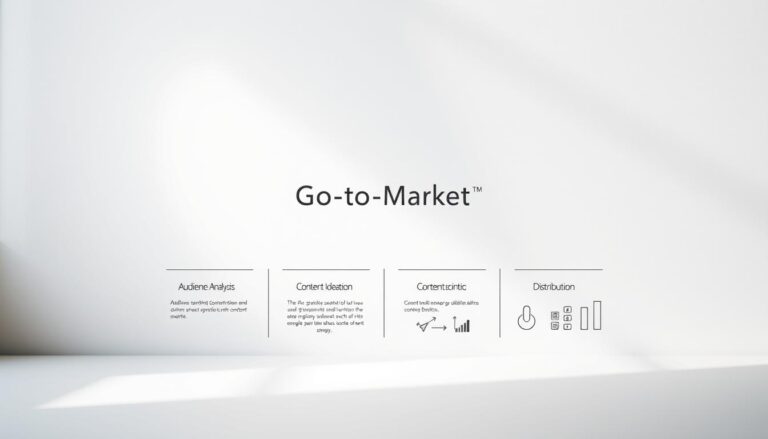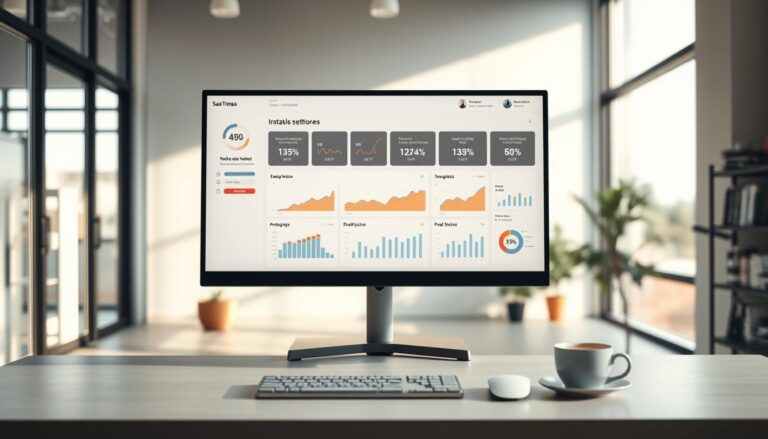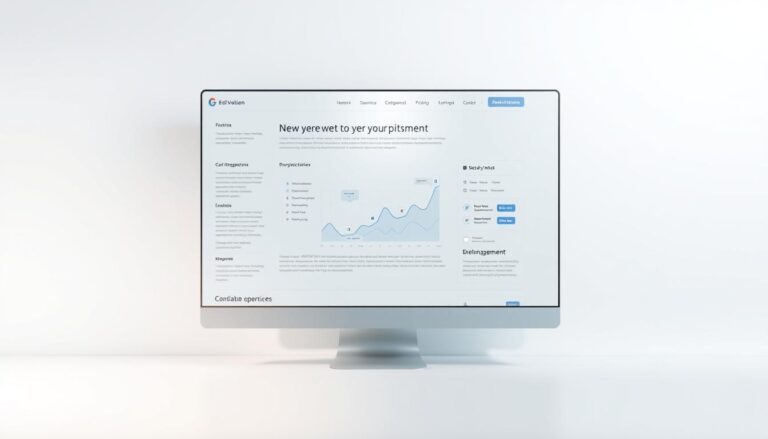Marketing automation tools are changing how businesses talk with their audience. These tools help create strong, personalized ways to communicate. Using them makes teams more productive, especially when making email campaigns that customers like.
Businesses can now adapt quickly to what their consumers want thanks to these tools. They use smart tech to make personalized experiences even better. Marketing pros can guess what customers need and reach out in the best way.
Adding smart analytics means every campaign’s success can be tracked. This gives important information that helps in making smart choices.
Marketing automation software is essential in modern marketing. It’s key for growing your business through new leads and sales. Plus, it helps in making strong relationships with customers.
Key Takeaways
- Marketing automation software is indispensable for personalizing customer engagement and increasing conversion rates.
- Integrating digital marketing automation tools allows for real-time data-driven segmentation and targeting.
- Efficient automation tools are key to managing multi-channel campaigns and enhancing customer experiences.
- Advanced software solutions for marketing automation are equipped with predictive analytics to fine-tune messaging strategies.
- Successful implementation of automation results in significant operational efficiencies and strengthened customer relationships.
- Keeping up with marketing automation trends is essential to maintaining a competitive edge in the digital landscape.
Introduction to Marketing Automation Software
Businesses are always on the lookout for smart ways to improve their marketing. Automated marketing solutions play a key role in this. AI-powered marketing automation platforms boost efficiency, enhance engagement, and lift marketing performance.
What is Marketing Automation?
Marketing automation is smart tech that takes over routine marketing tasks. It lets businesses send targeted messages through email, web, social media, and texts. These tools help companies efficiently reach out to customers with personalized content. This turns potential buyers into happy customers. It’s not just about automating tasks. It’s a strategy for managing and measuring marketing campaigns all in one place.
Key Benefits of Marketing Automation
The top software for marketing automation gives many important benefits:
- Teams save time by automating routine tasks, letting them focus on more creative work.
- It lets businesses tailor their interactions with customers, making every experience special.
- With targeted offers, businesses can speed up sales and grow their income.
- Using detailed data, companies can make smarter choices for their marketing strategies.
So, using marketing automation systems helps businesses work smoother and get better results. This makes marketing automation crucial for today’s marketers.
Types of Software Solutions for Marketing Automation
The advanced marketing automation software market offers many options. These tools help with email marketing campaigns, CRM, and managing social media. They aim to make work easier, boost personalization features, and keep customers engaged on different platforms.

Email Marketing Automation
Advanced marketing automation software sees email marketing as key. It lets businesses send emails automatically when customers take certain actions. ActiveCampaign, for example, excels with its approach to email automation based on behavior, which improves both campaign efficiency and personalization.
CRM Integration Solutions
Linking CRM with marketing automation tools helps sales and marketing work better together. It improves how they handle data and relationships with customers. Brands like HubSpot make it easy to keep track of customer info through their CRM integration, enhancing outreach quality.
Social Media Automation Tools
Social media tools are vital for a strong marketing strategy. They allow for scheduled posts, engagement management, and performance analysis. These tools help maintain an active social media presence, which is crucial for driving marketing efforts across channels.
| Software | Starting Price | Free Plan Available | Notable Feature |
|---|---|---|---|
| HubSpot | $800/month | Yes | Comprehensive CRM integration |
| ActiveCampaign | $15/month | No | Behavioral email automation |
| Mailchimp | $13/month | Yes | User-friendly email builder |
| Omnisend | $16/month | Yes | Advanced segmentation and reporting |
| Adobe Marketo Engage | $895/month | No | AI-driven analytics tools |
Diverse software options are available in the marketing automation field. They support various digital marketing needs, from email campaigns to CRM and social media handling. These solutions highlight how crucial technology is for marketing success and personalization.
Selecting the Right Software Solution
Finding the right tools for marketing automation starts with knowing your marketing needs well. This helps improve how you operate, make your customers more involved, and raise your sales. So, it’s key to pick marketing software in a well-planned way.
Assessing Business Needs
When picking marketing software, think about how it works with what you already have, like CRM. Check if it has API for adding more features later, which is vital. A good tool fits your business aims and can make sales teams work better, up by 14.5%.
Comparison of Features
Understanding what each software can do is the first step in evaluating them. For example, HubSpot Marketing Hub is great for running drip campaigns on different channels. On the other hand, ActiveCampaign combines email marketing with CRM well. And tools like Klaviyo can cut costs of getting new customers, proven by fashion retailer Veronica Beard.
Below is a table comparing key features of top marketing automation platforms:
| Feature | HubSpot Marketing Hub | ActiveCampaign | Klaviyo |
|---|---|---|---|
| Email Marketing | Advanced | Advanced | Basic |
| CRM Integration | Comprehensive | Comprehensive | Limited |
| API Access | Yes | Yes | Yes |
| Ad Workflow Automation | No | No | Yes |
| Customer Support Quality | High | High | Medium |
| Personalized Experience Capabilities | Yes | Yes | Yes |
Budget Considerations
When setting a budget for marketing automation, weigh the cost against what you get. Personlizing ads can make people 80% more likely to buy from you. So, spending more on a platform that makes ads better could be worth it.
It’s important to see if what you’re getting is worth the cost. Your choice should not just help now but also in the future with growth and support.
Implementing Marketing Automation Software
Companies want to improve their digital marketing strategies these days. Implementing marketing software is key for streamlining work and boosting how we connect with customers. The marketing automation setup might seem tough, but with the right steps and prep work, it leads to successful software deployment. Let’s dive into how to integrate this smoothly and the vital training and support that comes with it.
Steps for Successful Implementation
The first step in implementing marketing software is doing a deep dive into current marketing and sales approaches. This ensures the software matches our business goals well. It’s crucial to pick a platform that works with current CRM systems and can grow with your company. Systems like HubSpot Marketing, Omnisend, and Klaviyo offer many features for different needs, making marketing automation setup easier.
A clear sign of successful software deployment is when the software can handle complex tasks automatically. This includes sending out email newsletters, organizing drip campaigns, scheduling social media, and managing site content dynamically. Creating automated triggers from customer actions and designing custom workflows are key actions. They help in managing customer onboarding, leading nurturing, and checking performance.

Training and Support Options
After launching the marketing automation setup, its ongoing success depends a lot on training the users. Most providers offer detailed customer support. This includes tutorials online, forums, webinars, and personal coaching sessions. This support is essential not just for solving problems but also for helping users get the most out of the software.
Industry stats show 85% of B2B marketers think they’re not using their marketing automation software fully, often due to insufficient training and support. Companies like HubSpot and Klaviyo stand out not just with their advanced features but also with their vast educational resources. These resources help users make the most of automation technology.
The real signal of successful software deployment in marketing automation shows in better marketing efficiency and more customer interaction. Reports from the industry indicate big rises in lead generation and conversion rates after implementing automation, showing its game-changing effect.
Best Practices for Using Marketing Automation
Using marketing automation means you should follow top practices to connect well with your audience. This includes setting up your software and planning every campaign detail. It’s all about personal touch; using personalized emails, tailored messages, and campaigns that match with what your data tells you.
Content Personalization
Personalizing content sits at the heart of successful marketing automation. It’s vital to act on what you know about your audience, using behavior as clues. This means making every message fit the person’s interests by knowing them better and dividing your contacts so everyone gets something relevant. Such personalized touch greatly boosts how effective your campaigns are, increasing the likelihood of getting a positive response.
Campaign Segmentation
Creating individualized campaign strategies requires deep segmentation. You might segment by demographics, buying history, or how much they interact. This approach, combined with personalized emails, leads to more people opening your messages and engaging, as shown by industry leaders.
A/B Testing Strategies
It’s important to always be testing. A/B testing lets marketers fine-tune everything from email subject lines to when messages go out. By constantly analyzing performance and sticking to a structured testing plan, you make your campaigns more effective. Plus, you gather key learnings for the future.
| Strategy Component | Description | Impact on Engagement |
|---|---|---|
| Behavior-Based Triggers | Automate interactions based on user actions. | Increases relevance and conversion chances. |
| Integrating Sales Teams | CRM integration for seamless synergy between marketing and sales. | Enhances conversions through enriched conversations. |
| Nurturing Advocacy | Turn customers into brand advocates with automated loyalty offers. | Drives long-term growth and brand loyalty. |
Key practices like personalized email, unique messages, and distinct campaigns fast-track your marketing success. They ensure messages hit the mark, leading to strong results. Adopting these strategies helps craft impactful messages. It lays a solid foundation for ongoing growth and interaction with your audience.
Metrics to Measure Marketing Automation Success
To understand how well marketing automation works, it’s vital to look at key email campaign metrics closely. By keeping an eye on these numbers, companies can fine-tune their plans. This will help them hit their marketing goals better.
Key Performance Indicators (KPIs)
There are several essential marketing KPIs to watch to measure marketing automation success. These include open rates, click-through rates, conversion rates, and how they affect revenue. These figures show how engaged people are. They also tell us if the automation is turning potential customers into actual buyers. When these metrics are high, it means the marketing messages are hitting the mark. They’re getting people to act the way the company hopes.
Tools for Tracking Metrics
Measuring these KPIs well needs powerful tools. The right tools can thoroughly track and analyze how well marketing automation is doing. They give detailed reports and visuals on campaign success. This lets marketers see what’s working and what’s not. Some advanced tools even allow marketers to focus on specific groups of people. This means they can tailor their efforts better, using their resources more wisely.
For marketing automation to reach its full potential, getting good at gathering, analyzing, and using data from marketing KPIs is key. Thanks to new tech, data-driven marketing is more precise than ever. This gives companies the info they need to keep improving their marketing moves.
In the end, being able to measure how well your marketing efforts are doing with clear data is crucial. It helps in fine-tuning strategies and reaching real success that you can see and measure.
Case Studies: Success Stories in Marketing Automation
Looking into marketing automation success stories shows us big wins and efficiency leaps. By studying these automation successes, we learn about technology’s vast abilities. This also shows what makes a brand strategy work well.
Examples from Leading Brands
Virtual Logistics revamped its operations, seeing a 10 times boost in efficiency through automation. McAfee boosted its conversion rates by four times. This helped improve how they qualify leads and align marketing with sales. Paper Style enjoyed a 244% jump in email opens and a 161% rise in clicks, leading to a 330% revenue increase.
Thomson Reuters, with smart automation, raised its leads by 23% and revenue from marketing by 175%. Obama’s 2012 Campaign also benefited from automation. It played a big part in his reelection by improving volunteer screening.
Lessons Learned
These examples show us key lessons. Personalizing messages and acting on time is crucial, as TruWood’s success with SMS campaigns proves. Also, targeted email campaigns can raise revenue by up to 760%.
Automation means less work but more rewards, like Draper James making 15.4% more revenue with far fewer emails. Using AI for personal content has worked wonders for Birdies, bringing a 16% increase in conversions.
| Brand | Improvement | % Increase |
|---|---|---|
| Virtual Logistics | Operational Efficiency | 1000% |
| McAfee | Conversion Rate | 300% |
| Paper Style | Revenue | 330% |
| Thomson Reuters | Leads to Sales | 23% |
| Draper James | YOY Revenue Increase | 15.4% |
| Birdies | Conversion Rates | 16% |
These automation success stories confirm an essential truth. When done right, marketing automation boosts efficiency, increases revenue, and keeps brands ahead in market innovation.
The Future of Marketing Automation Software
Marketing technology is changing fast. It’s crucial to stay updated with future marketing technology trends. The upcoming growth phase brings innovations in marketing automation. These offer new ways to be efficient and connect with customers. With the need for data-driven strategies, personalization is becoming a must-have for customers.
Emerging Trends to Watch
Technological advances are revolutionizing marketing automation. Predictive AI is helping businesses save a lot of money. Its importance can’t be ignored. AI also creates unique images for content, making every digital interaction special. Moreover, since over 90% of people worldwide use mobile devices, focusing on mobile is key. A shocking 90% of businesses are now working on personalization tech. They aim to make messages more engaging and fitting.
The Role of AI in Marketing Automation
AI’s growth in marketing automation is changing the game. It lets platforms offer detailed and unique customer experiences. This increases the chances to engage with more people. Chatbots are now surprisingly good at talking to users. Machine learning makes AI even smarter, helping predict marketing trends accurately. And as the market for marketing automation is expected to hit USD 9.5 billion by 2027, the importance of AI and machine learning is clear. They’re not just trends but the foundation of modern marketing automation. This ensures deeper and more satisfying interactions with customers.
FAQ
What is Marketing Automation?
Marketing automation is about using technology to automate marketing. It deals with managing campaigns across different channels automatically. This includes tasks like generating leads, segmenting audiences, retaining customers, and measuring marketing success.
What are the Key Benefits of Marketing Automation?
The main benefits are better operational efficiency and more effective campaigns. This efficiency comes from personalization and targeting. It also leads to improved customer experiences and stronger analytics for measuring success and ROI.
What Types of Marketing Automation Software Solutions Are There?
There’s a range of solutions. This includes email marketing automation, CRM integration for aligning sales and marketing, and social media tools for scheduling content and engaging audiences.
How Can Email Marketing Benefit from Automation?
Automation enhances email marketing by sending more personalized emails and triggered communications. It also helps in efficiently segmenting audiences and saves time on repetitive tasks. This improves engagement and conversion rates.
Why is CRM Integration Important in Marketing Automation?
Integrating CRM with marketing automation aligns sales and marketing data. It allows for better targeting, personalization, and understanding of the customer journey. This leads to increased sales effectiveness.
What Are Social Media Automation Tools?
These tools help marketers schedule posts, track engagement, and analyze performance. They ensure a consistent and strategic presence on social media. This saves time and resources.
What Should Businesses Consider When Selecting Marketing Automation Software?
Businesses should evaluate their needs, like features and scalability. They should also consider integration capabilities, user-friendliness, and how the software fits with current workflows. Finding a cost-effective solution is key.
How Do You Compare Features of Marketing Automation Software?
Compare based on automation extent, channel diversity, and analytics tools. Also, look at ease of use, integration with existing systems, support, and scalability.
What are the Budget Considerations for Marketing Automation Tools?
Understand the pricing model, which can vary based on features and usage. Assess long-term value versus the initial cost to ensure it meets business goals without overspending.
What Steps are Necessary for Successful Implementation of Marketing Automation Software?
Success involves planning a content strategy, integrating with CRM systems, and managing data well. Also, ensure your marketing team is trained to use the software effectively.
What Training and Support Options are Available for Marketing Automation Software?
Providers offer online tutorials, help desks, forums, and sometimes personalized training. These help businesses make the most of their automation platforms.
How Can Content be Personalized Through Marketing Automation?
Personalization uses AI and machine learning to analyze behavior. It segments audiences and triggers messages based on customer actions. This makes content more effective and improves engagement.
Why is Campaign Segmentation Important?
Segmentation lets marketers target specific audience groups. This ensures content matches their interests and behaviors. It makes marketing communications more impactful.
How Can A/B Testing Improve Marketing Automation Strategies?
A/B testing compares different campaign versions to find what works best. By testing elements like subject lines, marketers can refine their strategies for better results.
What Key Performance Indicators Should Marketers Track?
Track open rates, click-through rates, conversion rates, and ROI. These KPIs show how well automation efforts are working and where to improve.
How Can Tools for Tracking Metrics Enhance Marketing Automation?
Tracking tools provide insights into campaign performance. They help understand audience behavior, evaluate strategies, and optimize future campaigns based on data.
What Insights Can We Gain from Marketing Automation Case Studies?
Case studies reveal how businesses successfully use automation. They offer best practices, innovative ideas, and common pitfalls to avoid for successful outcomes.
What Role Will AI Play in the Future of Marketing Automation?
AI will enhance personalization, predictive analytics, and real-time campaign optimization. It promises a more dynamic and effective customer experience.



